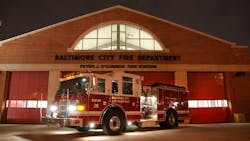Baltimore City's Aging Fleet, Stations Focus of Hearing
Baltimore City Council members on Tuesday questioned Fire Department officials about the agency’s aging vehicles and stations and demanded more information on staffing policies and overtime costs.
The council members who sit on the public safety committee asked the department to provide them with data on its operations to help determine how best to allocate resources to improve response times, repair aging firehouses and vehicles, and provide proper overtime pay to employees.
The department’s faulty payment system has been miscalculating overtime pay since at least 2017, requiring the Fire Department to pay more than $180,000 to correct mistakes between Jan. 1, 2017, and Jan. 15, 2019. The problem has still not been fixed, Chief Niles Ford told the committee.
“It’s still going on?” asked Councilman Brandon Scott, chairman of the public safety committee.
“Yes,” Ford replied.
RELATED:
- Baltimore City FD 'Well-Equipped' Despite Out-of-Service Units
- Baltimore City Mayor Promises $1.2M Apparatus
- Baltimore City Apparatus Catches Fire
- Baltimore City FD Faces Questions over Apparatus Fire
Scott asked for the department to provide more information on the pay situation.
He also demanded that Ford provide a detailed account of the conditions of all 38 fire stations across the city to avoid having to close any because of hazards, such as a decrepit roof that recently shuttered a firehouse on Reisterstown Road.
Repairs were not completed because the $296,000 cost to fix the roof was too expensive, officials said.
Scott said he found it “hard to believe” that city officials were not aware that the roof was deteriorating until the building suddenly had to be closed for safety, an abrupt closure that resulted in trucks being relocated from the station and alarm among neighbors about emergency response times.
The city has “nickle-and-dimed ourselves into this situation,” Scott said during a public safety committee hearing at City Hall. “We can’t afford to have other things like this happen.”
Steve Sharkey, director of the city’s general services department, said the Fire Department needed more money to properly maintain firehouses.
The general services agency budgeted $10 million for capital costs at fire stations. A spokesman for Mayor Catherine Pugh said she added $1 million to the capital budget for next year.
“We need $50 million,” Sharkey said. “The buildings are going to get worse.”
Ford said the department frequently shifted vehicles from one station to another and maintained certain “redundancies” in the fleet to “make sure we can get the best responsive times."
In 2017, the latest year for which statistics are available, the Fire Department had an engine respond to a fire within five minutes 95 percent of the time, beating a 90 percent goal.
But it missed a target of having emergency medical crews respond within eight minutes 90 percent of the time; instead it did so 45 percent of the time. Dispatchers narrowly fell short of goals for how quickly they should answer and handle calls.
Scott called the oversight hearing after several high-profile events related to the Fire Department’s fleet.
Over Christmas, two stations were temporarily out of service because they lacked equipment. A department spokeswoman said then that its ability to provide emergency services was not affected. But Pugh subsequently set into motion plans to buy an extra $1.2 million firetruck.
Both out-of-service trucks were repaired and placed back into service, and two new ones, purchased in fiscal years 2017 and 2018, joined the fleet last month, said Blair Skinner, a Fire Department spokeswoman. A third truck, ordered in the 2019 fiscal year, arrived this month and will go into service within a few months, Skinner said.
Baltimore did not order any new firetrucks from 2009 until 2011, delaying the costs of updating its fleet, according to the department and the International Firefighters Association Local 734, the union representing rank-and-file firefighters and paramedics.
Then, last month, a firetruck caught fire — and it wasn’t the first time it’s happened in Baltimore. The union said the truck was 17 years old.
IAFF Local 734 President Richard “Dickie” Altieri posted about the incident on his Facebook page, saying the rescue truck was responding to an incident on Interstate 95 when it caught fire. He said it shows that the “dilapidated fleet needs attention sooner than later.”
Altieri said he was pleased that Scott was demanding answers to important questions.
Scott also asked Ford to provide the council with details on how the department staffs stations to make sure there are enough paramedics to meet the massive demands for emergency medical services. In fiscal year 2018, the department responded to 36,542 fire suppression calls and 154,084 emergency medical calls.
“If we know we are short, why not ask for more medic units so we don’t pull from other areas?” Scott said.
Councilman Zeke Cohen commended firefighters for saving the lives of people who overdose from opioids, but wanted details on precisely “when and where” those incidents were taking place.
Scott also asked for more details on how the Fire Department could do more to help seniors prepare for fires. Between 2008 and 2018, 78 Baltimore residents over age 60 died in fires, the highest percentage among age groups. Scott wanted to know if any of the more than 36,000 smoke alarms installed by firefighters in 2018 were tailored to the needs of seniors who may be immobile or deaf.
“We don’t have any of those,” Ford said.
Special vibrating and high-decibel smoke detectors for seniors who may not be able to hear well cost between $188 and $300, a fire official said.
“We have to be innovative and also creative in the way we operate,” Scott said.
———
©2019 The Baltimore Sun
Visit The Baltimore Sun at www.baltimoresun.com
Distributed by Tribune Content Agency, LLC.
